FEZ – two days in Morocco’s oldest imperial city
Open Sesame: My two days in Fez, the oldest imperial city in Morocco with one of the most exciting historic old towns, were an absolutely magical introduction to a place from 1001 nights.
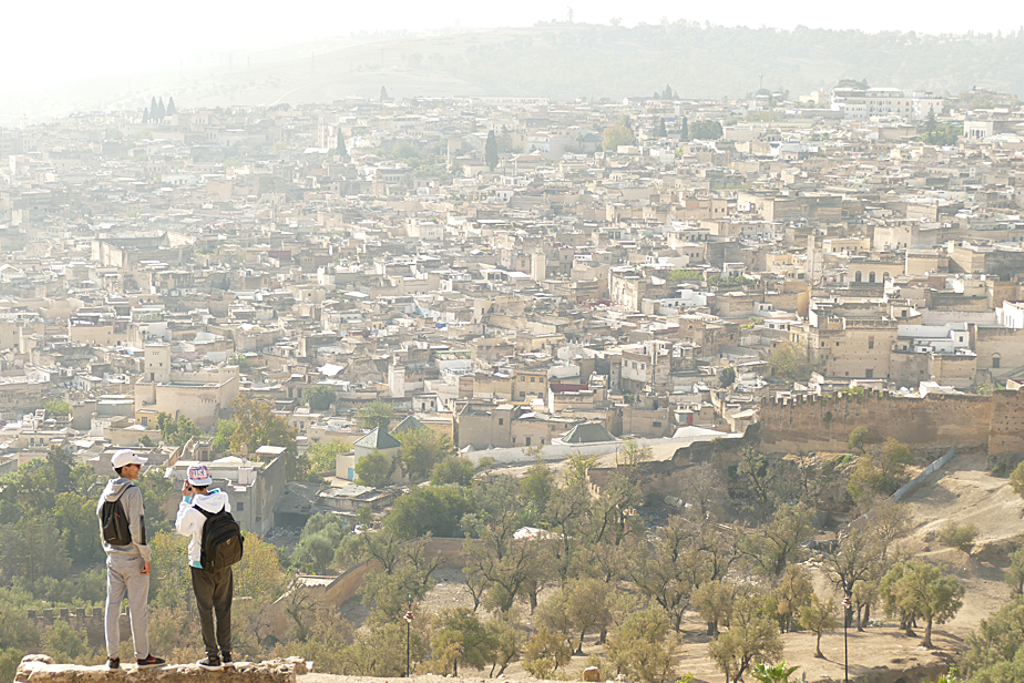 The imperial city of Fez at your feet.
The imperial city of Fez at your feet.
- Ahlan Wa Sahlan
- Walking Tour Through Fez Al Bali
-
16 Must-Sees in Fez
- Bab R’cif and Place R’cif
- Souks of Fez Al Bali
- Place Saffarine
- University Al Qarawiyyin
- Al Attarine Madrasa
- Chouara Tanneries
- Mausoleum of Moulay Idriss II
- Funduq Al Nejjarin And Museum of Wooden Arts And Crafts
- Bou Inania Madrasa
- Dar Al Magana Water Clock
- Bab Boujeloud
- Bou Jeloud Gardens
- Bab Semmarine
- Mellah of Fez
- Royal Palace
- Marinid Tombs And Viewpoints
- A Little Bit of History
- Practical Information
- Map
- Pinnable Pictures
Ahlan Wa Sahlan – welcome to Morocco.
There are times I really need to stick to my own advice. For instance, how to surpass pre-travel anxiety. As a matter of fact, I’m nervous before each and every trip. Actually, that’s why it was so easy for me to put together my post on Keep Calm and Travel Solo. I didn’t have to put myself into someone else’s shoes, I am wearing a nice pair of panic-slippers myself – before each trip. And going to Morocco by myself wasn’t any different. There was a buttload of what if’s. What if I lose my way in the Medina? Will some guy show me the way out only if I hand him a small fortune? What if cab drivers keep scamming me? What if someone keeps following me? Or harassing me to buy cheezy souvenirs?
Or…yes, there was a buttload of what if’s.
I was terrified.
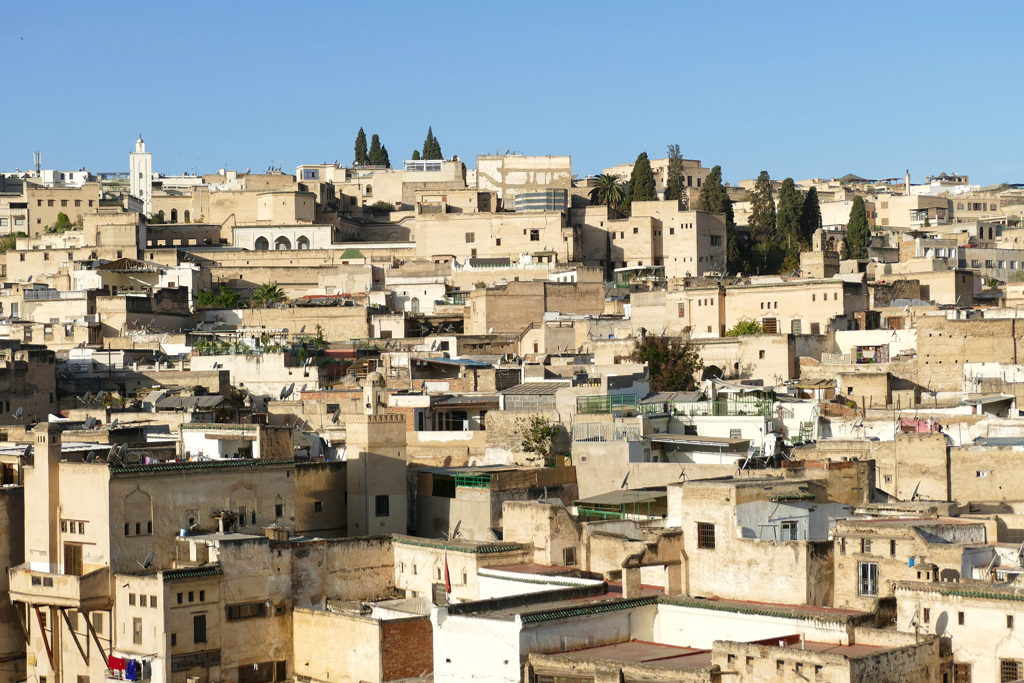 This looks by no means neatly organized.
This looks by no means neatly organized.
And as it always goes, as soon as I landed at the airport of Rabat-Salé, I was totally on top of my game. I got Dirham from an ATM, asked at the airport information how much a cab to the train station of Salé should be, and stepped into Morocco’s noonish heat, ready to face the world.
Nobody’s Fool
Or the first cab drivers. And as expected, the first one quoted triple what the gentleman at the information had told me. Nope, I’m not going with you.
And neither did I go with the second one who also wanted triple nor with the third one who asked for the same.
You know what, forget it, I’m taking the bus to the train station in Rabat.
That very moment, out of the blue, appeared a fourth cab driver asking for the 50 Dirham that should be the correct fare. I was so perplexed that I confirmed this modest amount in French as well as in Arabic before heaving my suitcase into the trunk.
I had won the first battle against the cab mob.
Great question, I’m so glad you asked.
Well, obviously, this is a transcript from Arabic where it’s clearly written with an S. Yet, I prefer the alternative spelling with a Z since it’s the English way and my blog is written in English.
Regarding El or Al, in Arabic, there is only one vowel for both, the letter A as well as the letter E, hence, it’s totally up to you which one you use for your transcription. I personally prefer Al.
Howsoever, none of these versions are wrong.
After a three-hour train ride from Salé to Fez, however, I was not such a trooper anymore. I was tired, it was after dark, I didn’t see a point in haggling over the equivalent of two or three Euros – just take me to my Riad and we both call it a day.
That’s, by the way, one of my most valuable tips: If your safety, your well-being, and peace of mind are at stake, it shouldn’t matter that your mean of transportation comes with a price tag! Or any other service, for that matter.
Walking Tour Through Fez Al BaliMy first morning in Fez proved that there was nothing to be nervous about. I did not get lost in the Medina, people did not take advantage of my disorientation, they didn’t follow me, nor did they insist on selling me cheezy souvenirs. They were helpful and friendly and made it possible to find my way to the post office where I was supposed to meet Abderrahim.
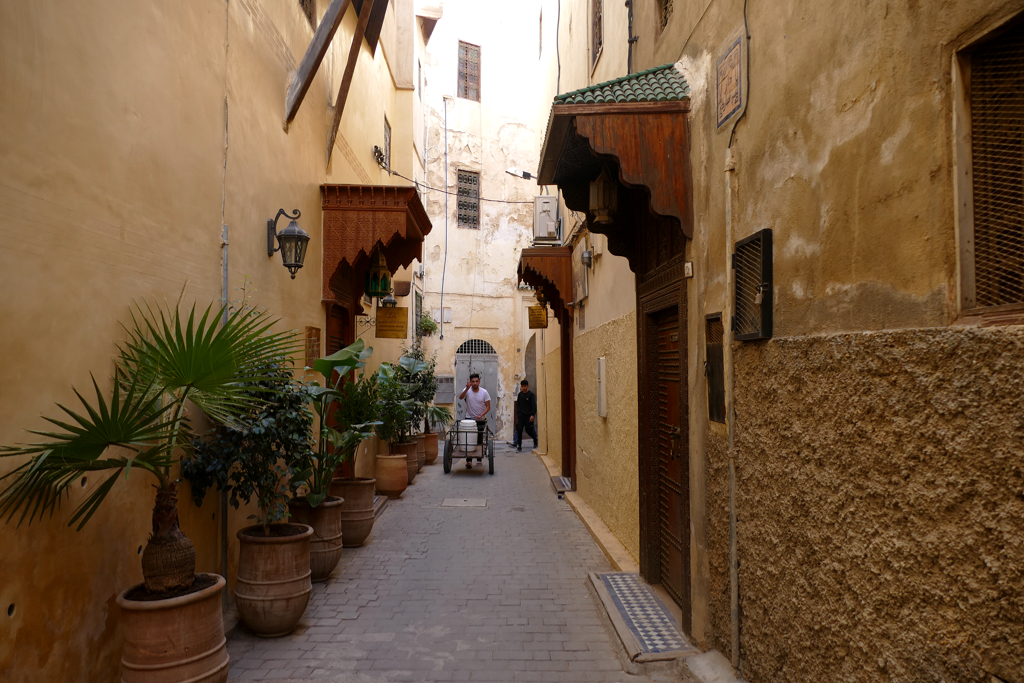 You never know what’s around the next corner.
You never know what’s around the next corner.
Who’s Abderrahim? I’m so glad you asked. Abderrahim is a guidebook on two legs and he’s generous enough to share his knowledge with visitors to his hometown Fez. Most importantly, he is a pleasure and great fun to be around.
A Guiding StarAs soon as our group is complete – there is Elena from Spain with her Italian boyfriend, Davide from Milan, a sweet couple from Kuala Lumpur whose names I sadly cannot remember, and me – Abderrahim navigates us through some of the thousands and thousands of alleys that make up this crazy maze which is the Medina of Fez. Actually, UNESCO couldn’t resist putting this oriental wonderland on its list of World Heritage in 1981. Since then, there is money floating in to save those wonderful architectural masterpieces lining those alleys and transforming them into a maze.
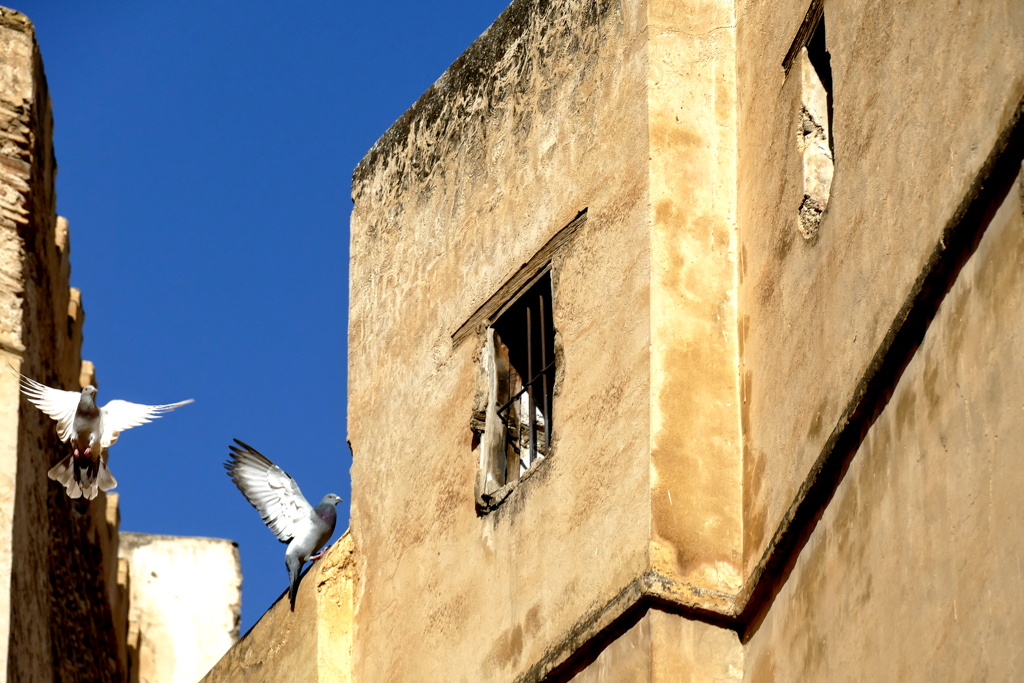 Until those old structures are fixed, they are occupied by some winged tenants.
Until those old structures are fixed, they are occupied by some winged tenants.
As Abderrahim is guiding us through this world-famous labyrinth, he sharpens our eyes for details and hints. At the end of this wonderful tour, I actually feel ready to explore more all by myself.
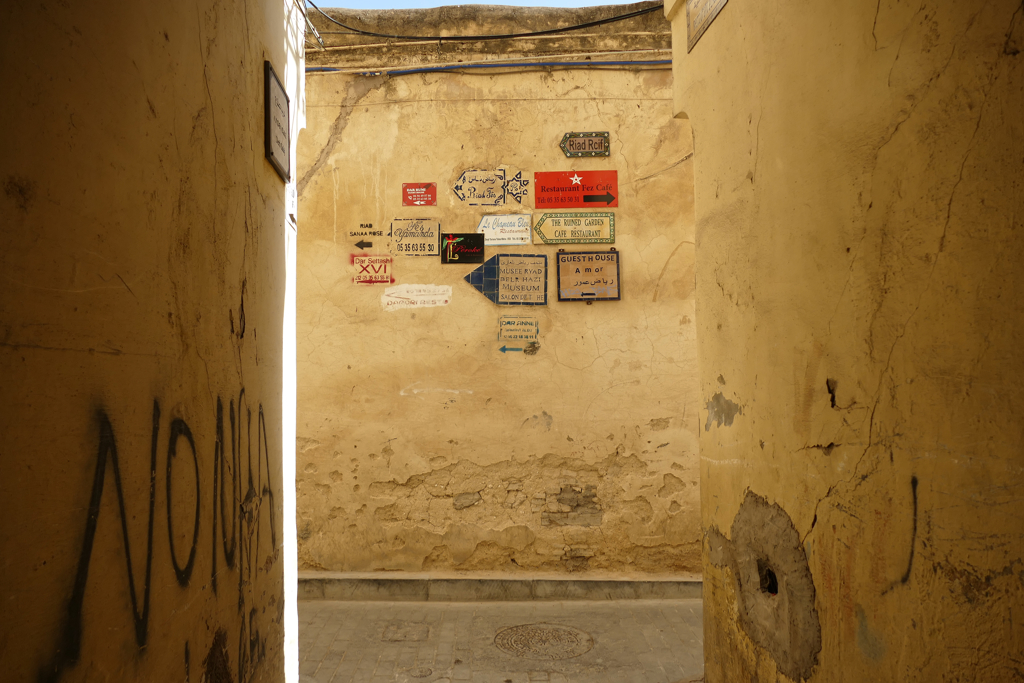 Even with these modest hints, navigating through Fez’s old town can become a challenge.
Even with these modest hints, navigating through Fez’s old town can become a challenge.
With an unspoken Open Sesame, Abderrahim opened the gates to many wonders in Fez’s medina and braced me for two truly amazing days.
Below, you’ll find the spots’n’landmarks I believe you should definitely see on your visit to Fez.
16 Must-Sees in Fez Bab R’cif and Place R’cifSince my Riad was on the eastern side of the Medina, close to the R’cif square, I start my guide there.
The Fez river is dividing the city into two major parts, namely the Andalusian neighborhood in the east and the Tunisian part. This distinction goes way back to two waves of migration, I’m explaining them below. Today, the Andalusian part of town is a rather poor district where there actually isn’t much to see.
An exception is the Place R’cif with the imposing Bab – whereby Bab translates to gate. Since the Riad where I stayed was just a stone’s throw south of the square, Place R’cif became quickly kind of my hood.
There’s a lot going on around the large square, and fortunately, there are some eateries from where you have a great view of all the hustle and bustle.
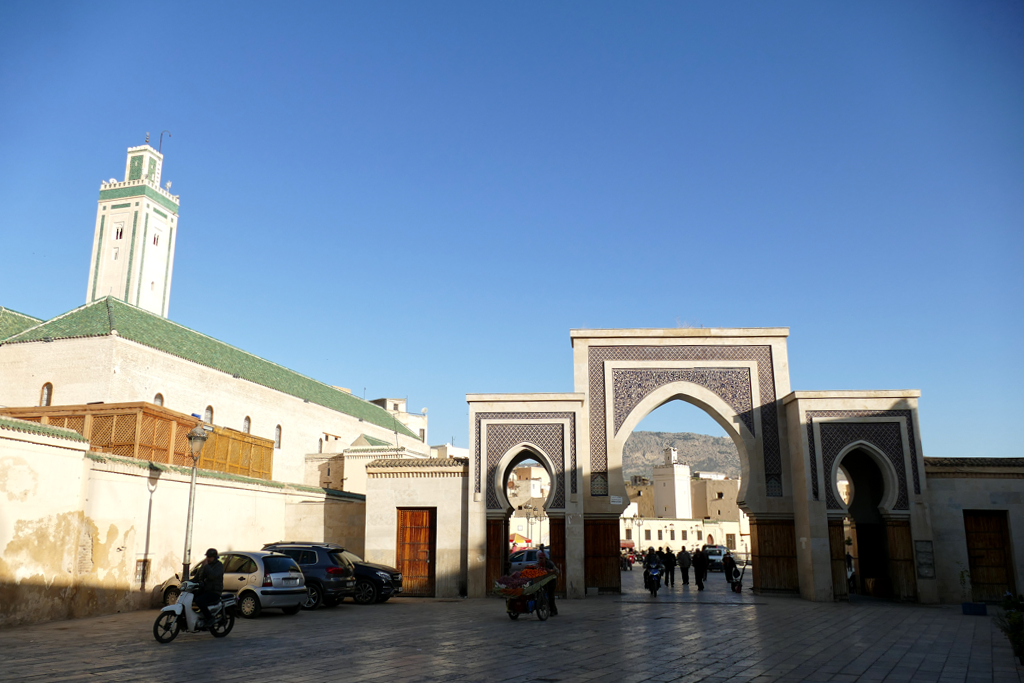 Bab R’cif in the center of the eponymous R’cif square with the R’cif-mosque to the left.
Bab R’cif in the center of the eponymous R’cif square with the R’cif-mosque to the left.
The adjacent Terrafina bridge is one of the entrances into the Medina. But before you dive head over heels into the craziness, take a quick look at the R’cif mosque with its elegant minaret. The Alawid Sultan Moulay Slimane commissioned it in the 18th century.
Around the western part of the square runs a narrow covered gallery where fruits, vegetables, fish, and meat are sold.
Souks of Fez Al BaliAs I said, as soon as you cross the Fez river over the Terrafina bridge, you lose yourself in the thousands of small alleys of Fez el Bali, the oldest walled part of the city of Fez.
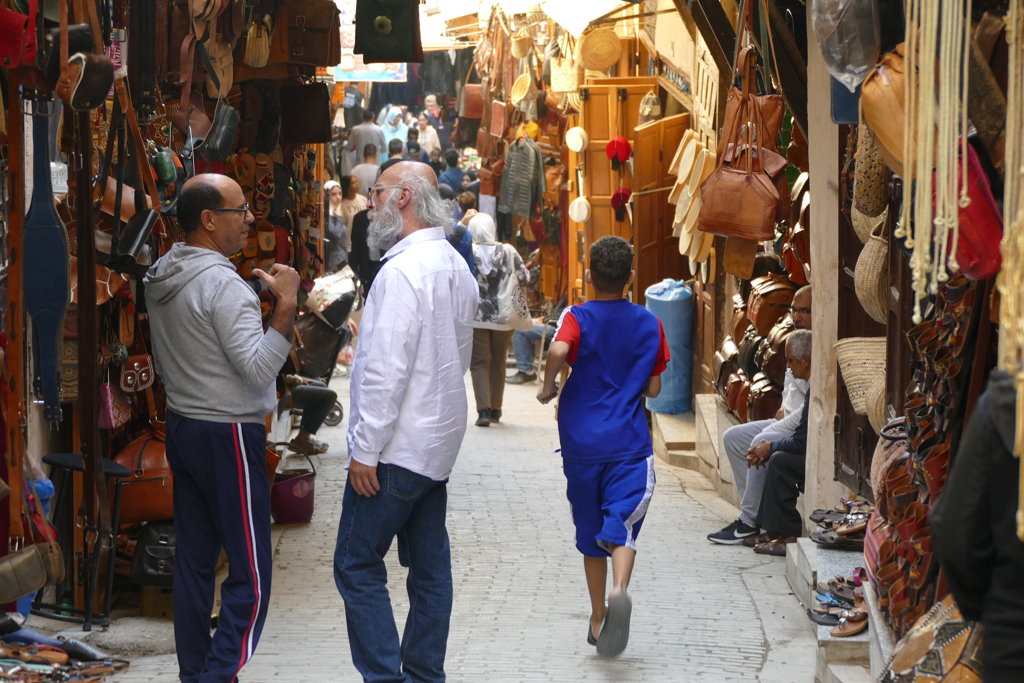 The souks of Fez Al Bali are not just a great spot for shopping, they are also a gathering place for the locals.
The souks of Fez Al Bali are not just a great spot for shopping, they are also a gathering place for the locals.
However, today, Fez Al Bali is mainly famous for various souks, hence, markets and shops where tourists tend to lose their way and spend lots of money on colorful oriental merchandise. Nevertheless, over 150,000 people live in Fez Al Bali. It is a strictly pedestrian area. As a matter of fact, it is the largest car-free area in the world based on the number of residents.
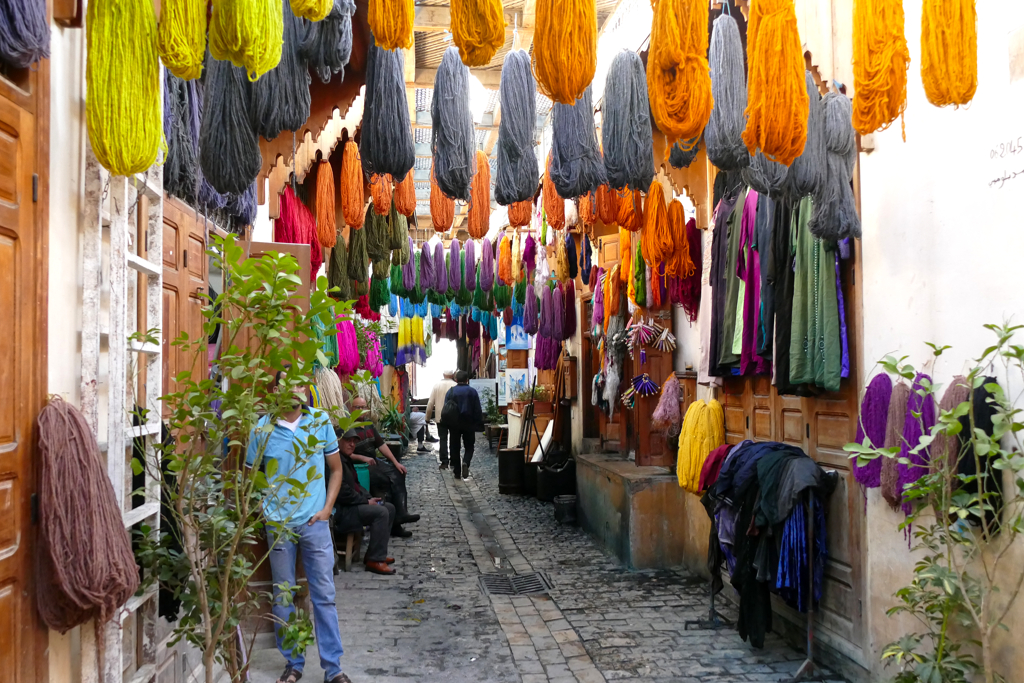 Wool in many colors: At the dyeing alley, they dye everything – from threads to hair.
Wool in many colors: At the dyeing alley, they dye everything – from threads to hair.
I have no sense of orientation whatsoever, therefore, I was petrified before my first visit to Fez Al Bali. But there is a trick: If you are like me and hate to get lost, you can simply stick to two main arteries, namely the Tala’a Kebira and the Tala’a Saghira. These two streets connect the western entrance of the city with the Al-Qarawiyyin area just around the corner from the famous Place Saffarine. As you then decide to turn into one of the narrow alleys, you can always come back to these two main roads so that you shouldn’t get lost.
Howsoever, you cannot claim having been to Fez without an extended walk through the narrow alleys which in some spots are incredible 50 centimeters wide. You have to meander between the countless shops and stalls selling the best in leather, woodcarving, copper, spices’n’sweets and many other high-quality products.
Place SaffarineI’ve already mentioned this square above because it’s bordering the world-famous university Al-Qarawiyyin from where you enter the Tala’a Kebira road.
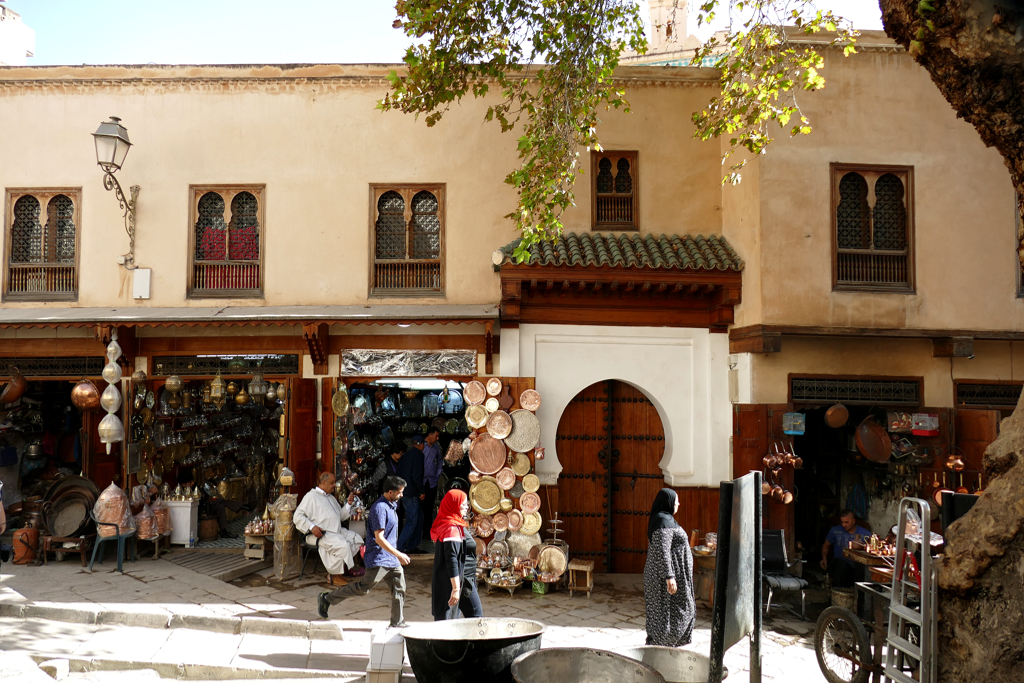 The Saffarin Madrasa was the first one of its kind to be built by the Marinids.
The Saffarin Madrasa was the first one of its kind to be built by the Marinids.
The Place Saffarine dates back all the way to the Middle Ages. It is framed by the Qarawiyyin’s library to the northwest and the Saffarin Madrasa to the east. It was founded by the Marinid Sultan Abu Yaqub Yusuf Al Nasr in 1271 and is considered the first madrasa built during the Marinid era.
Also, there is the Saffarin Hammam which dates to the 14th century.
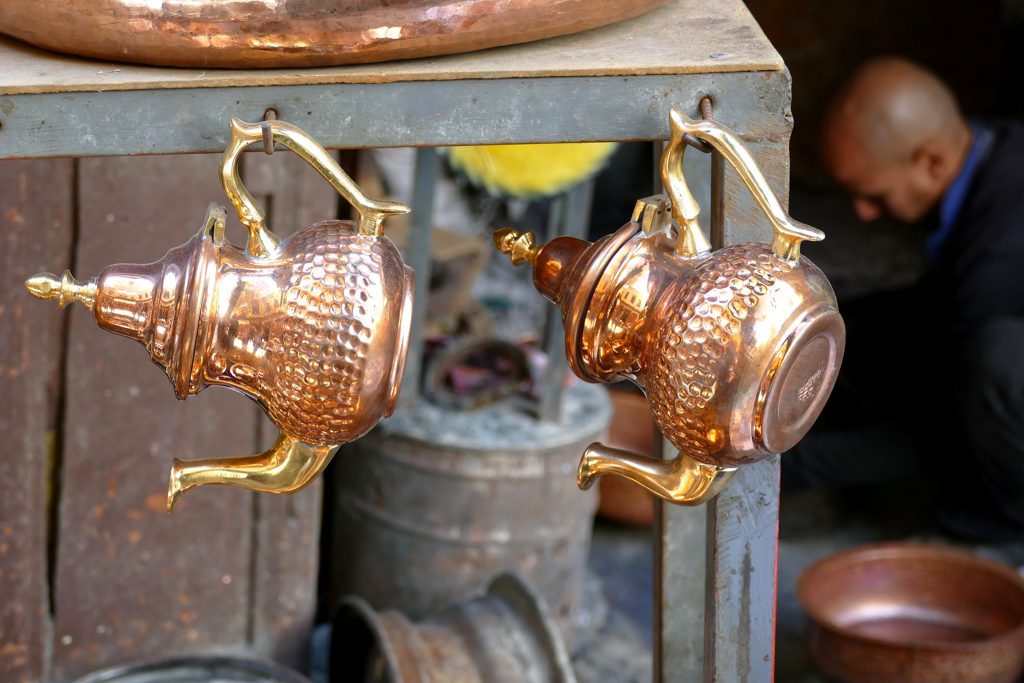 Coppersmiths – saffarin in Arabic – gave the vivid square its name. To this date, they produce and sell their beautiful works there.
Coppersmiths – saffarin in Arabic – gave the vivid square its name. To this date, they produce and sell their beautiful works there.
The square is named after the Saffarin which translates to coppersmiths. These craftsmen have had their workshops here for centuries. Today, they also hammer those metal plates for tourists, yet, there is a great variety of all kinds of handmade pots’n’pans, lampshades, and many decoration items.
University Al QarawiyyinThe university was founded as a madrasa, hence, a school where Islamic studies are taught, respectively as a mosque by Fatima Al Fihri in 859. The founder was the daughter of the wealthy merchant Mohammed Al Fihri. She had vowed to use all of her inheritance to build a mosque for her community which had immigrated from the Tunisian city of Kairouan in the early 9th century. Hence, the name of the university translates to University of the People of Kairouan.
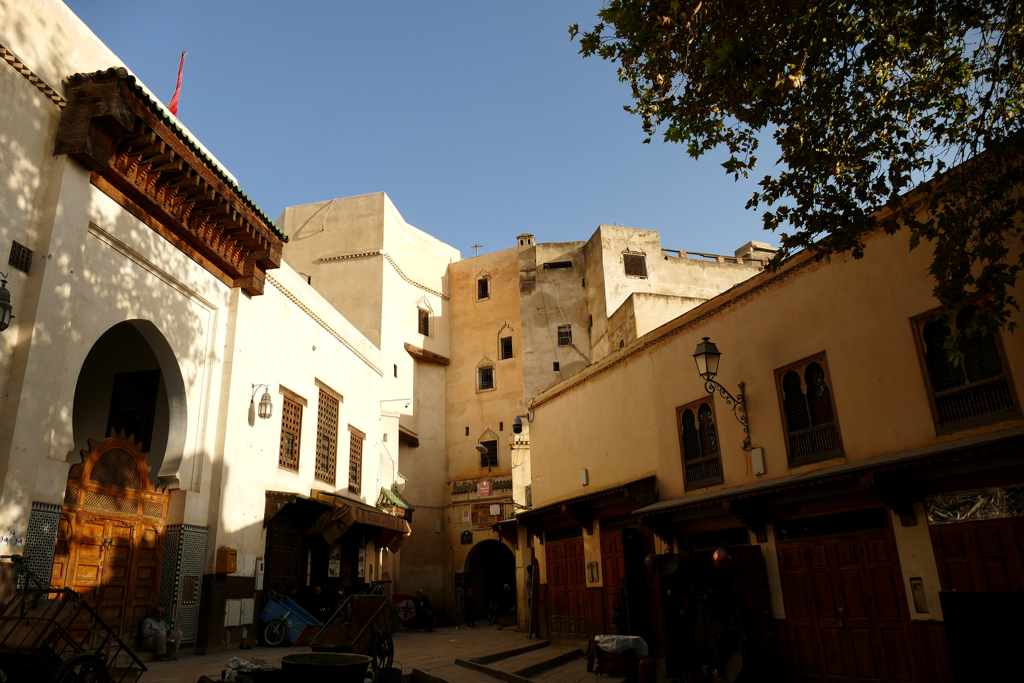 On the northern edge of Place Seffarine is the entrance to the Qarawiyyin library – here to the left. To the right the old Saffarine Madrasa.
On the northern edge of Place Seffarine is the entrance to the Qarawiyyin library – here to the left. To the right the old Saffarine Madrasa.
The Koran school came under the patronage of the powerful sultans. A large selection of manuscripts was collected and preserved in a library donated by the Marinid Sultan Abu Inan Faris in 1349.
In 1957, King Mohammed V added mathematics, physics, chemistry, and foreign languages to the curriculum. In 1963, the institution was incorporated into Morocco’s state university system.
According to the Guinness Book of World Records, the University Al Qarawiyyin is the oldest educational institution in the world.
Since it is a sacred building, non-Muslims are not allowed to enter.
Great question, I’m so glad you asked.
As a matter of fact, unlike in other Muslim countries, in Morocco, non-Muslims are not allowed to enter Mosques and some other sacred places like for instance the Al Qarawiyyin University.
Theoretically, I could have taken pictures of Mosques from the outside. But many Mosques in Morocco are not freestanding on some square but part of the tight complex of buildings within the Medina so it’s practically impossible to take a picture from a convenient angle.
Since the Al Attarine Madrasa is a former Koranic school and isn’t operated anymore, you can visit it. This way, you’ll get an idea of what all the other Madrasas and mosques are like.
The Al Attarine Madrasa is right next to the Qarawiyyin and borders the spice and perfume souk. It was commissioned by order of the Marinid sultan Abu Said Uthman and built between 1323 and 1325. Then, it was actually used until the early 20th century.
The building consists of various parts: There is a small antechamber and a large courtyard with a bordering prayer room with a mihrab niche facing Mecca. The tiny living and sleeping quarters of the students are in another annex.
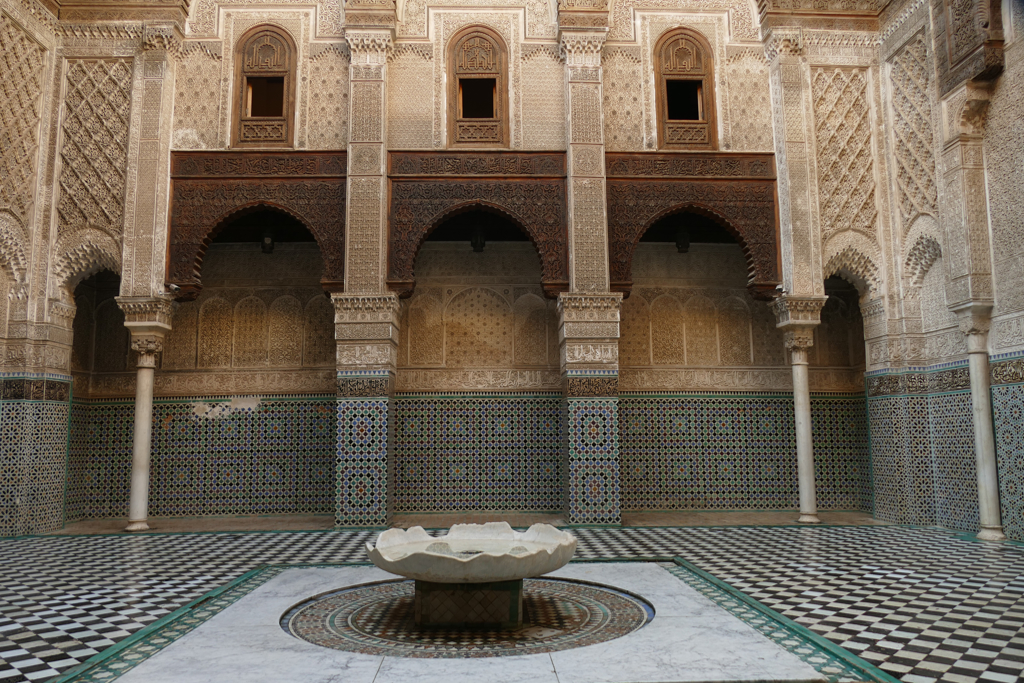 Al Attarine Madrasa in the early morning before the tourist masses arrive.
Al Attarine Madrasa in the early morning before the tourist masses arrive.
A multicolored tile mosaic covers the floor of the main courtyard. In the center is a fountain bowl made from marble. Above a plinth is an inscription with quotations from the Koran written on black-glazed tiles. The upper part of the walls is made of carved cedar beams that were brought to Fez from the Atlas mountains.
It’s amazing how the different materials and various designs form a harmonic result.
However, you will notice that the ornamental decoration shows almost exclusively abstract and geometric motifs. Floral shapes are sparse. Most importantly, there is no figurative decoration depicting people or animals whatsoever.
In my chapter on the Bou Inania Madrasa, you’ll find an info box explaining ornamentation in the Islamic context.
Great question, I’m so glad you asked.
In Morocco, non-Muslims are not allowed to enter any of the sacred buildings. The only exception is the Hassan II Mosque in Casablanca.
Many people mistakenly believe this is due to the Koran. But according to Islamic law, non-Muslims are allowed to visit mosques as long as it’s not during prayer time. Also, they have to stick to the proper decorum, obviously. Enforcement of this law varies greatly from country to country: While for instance, in Egypt and Turkey, anyone can enter a mosque, it is strictly forbidden in Saudi Arabia.
In the special case of Morocco, it was the French occupying forces who prohibited Europeans from entering mosques to create a respectful climate during the French protectorate. Although Morocco is no longer a French colony, this law is still in..
* This article was originally published here
Comments
Post a Comment